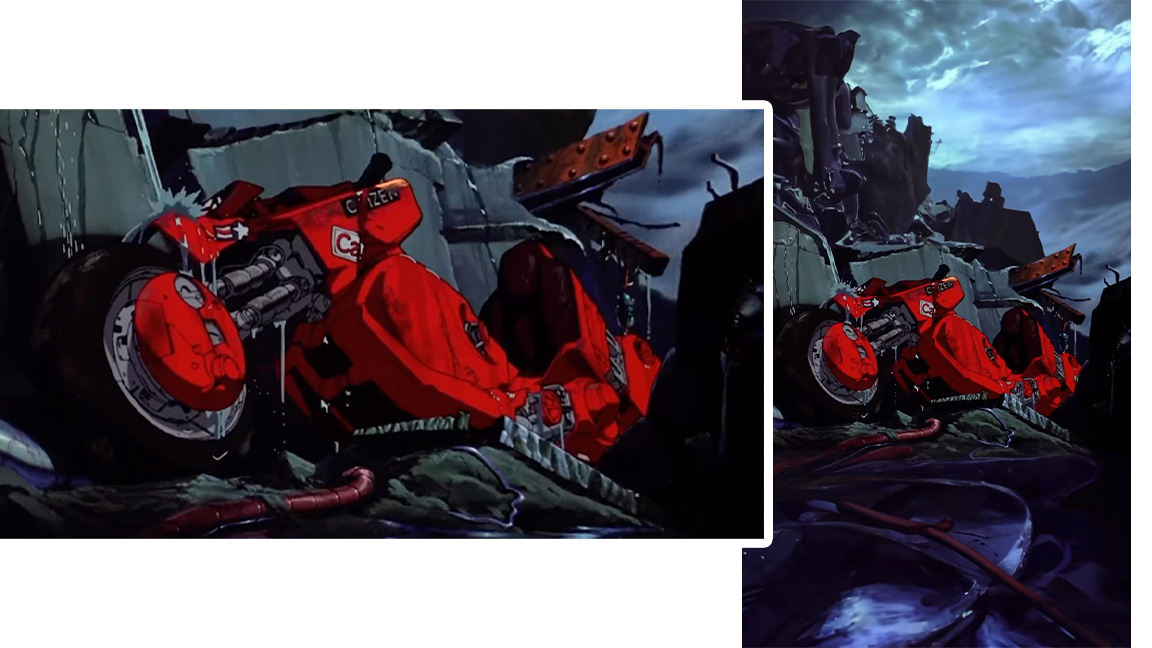Katsuhiro Otomo’s Akira movie is a stone cold classic that pushed what could be done with hand-drawn animation and inspired a generation of artists and designers, so naturally an AI user decides to fix it.
Creative director and AI advocate Eric Groza has used Adobe's new Generative Expand AI tool to alter the aspect ratio of Akira and fill in the extra space with seamless new detail. As he explains on Instagram, Akira was made on 35mm film (some sections expanded to 75mm) but it was shot in 16:9 ratio, horizontal ratio.
Groza's argument is even while Akira was "hand-painted with a level of detail would make Disney blush" when viewed in today's TVs you "miss out on the insane details". Of course, those 'details' don't actually exist. That's where the AI comes in, replicating Otomo’s art style the AI was able to "generate the extended areas piece-by-piece, rather than paint them in". (You can see it below.)
A post shared by Eric Groza (@gro3a)
A photo posted by on
AI use, good or bad?
So here's the thing, is this really terrible? My instinct is to raise an eyebrow and dislike someone, anyone, fiddling and altering a work of art like Akira, especially using an AI.
But what Groza is really showing here, in a contentious way that fans will be up in arms over, is to reveal how a tool like Adobe Generative AI can enable artists, designers and animators to speed up their workflow and iterate on their own ideas.
"Brands, productions and animation studios often just crop into a horizontal image to make a vertical format – which cuts out part of the action and often reduces image quality," writes Groza. "For artists, it means that they can augment their style and scale their work."
He adds: "It’s a win for the creative individual who wants to do more with their own hands. Already today, an artist can invent worlds and expand on them with a couple of clicks (and a lot of trial and error)."
Get the Creative Bloq Newsletter
Daily design news, reviews, how-tos and more, as picked by the editors.

Fans, however, hit back on Instagram, lead visual development artist Tad Lambert wrote: "This isn't a fix my guy. If the director wanted this, they would have done so. All you did was destroy the composition and great shots this anime had for wasted space. If you had knowledge of cinema at all you would know that this is pointless."
While artist and animator Xander Holland replied: "The audacity to think you have the right to "fix" someone else's work. Especially one that is considered one of the greatest animated films ever made."
This latest use of AI gets to the heart of why people love and hate the use of these new tools
For me, this latest use of AI gets to the heart of why people love and hate the use of these new tools. I've already written an article on the big issues facing generative AI and this gets to the nub of it; on the one hand an artist has found a way to improve their own workflow and do more with their art, but it's being exemplified using one of the greatest animated movies of all time.
Akira doesn't need fixing, but maybe there's a role for AI, such as Adobe's ethical AI called Firefly, to speed up workflows and do more with less. Just, maybe, don't go around 'fixing' movies everyone loves. If you do want to learn more, we have a great guide to using Adobe's Generative Fill and I also interviewed D&D artist Greg Rutkowski as an example of everything that's wrong with unethical use of AI.

Thank you for reading 5 articles this month* Join now for unlimited access
Enjoy your first month for just £1 / $1 / €1
*Read 5 free articles per month without a subscription

Join now for unlimited access
Try first month for just £1 / $1 / €1

Ian Dean is Editor, Digital Arts & 3D at Creative Bloq, and the former editor of many leading magazines. These titles included ImagineFX, 3D World and video game titles Play and Official PlayStation Magazine. Ian launched Xbox magazine X360 and edited PlayStation World. For Creative Bloq, Ian combines his experiences to bring the latest news on digital art, VFX and video games and tech, and in his spare time he doodles in Procreate, ArtRage, and Rebelle while finding time to play Xbox and PS5.
